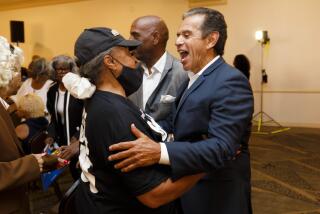Mr. Villaraigosa, don’t build this wall
At last, the city’s Planning Department says, Mayor Antonio Villaraigosa will have his security wall. In February, Villaraigosa’s office said it wanted to put a 6-foot-high fence in front of his official residence in Windsor Square. It wasn’t his idea to beef up security, he demurred; it was the LAPD’s. Not that the wall would stop a terrorist attack, but it would probably keep some kook from doing harm.
The mayor needed a zoning variance because the city limits fences and walls to 42 inches — a rule that is spottily enforced. In Windsor Square, however, there is a historic preservation zone and a cluster of rich and powerful residents. They didn’t want Getty House to become a fortress, guarded by battlements, side by side with handsome 1920s mansions with sweeping, open yards. The preservationists lost, trumped by the argument that the mayor needs his protective perimeter.
Residents were right to fight the wall; it will be a blight. But the real issue isn’t one of historic preservation or aesthetics. Nor is it a zoning problem.
The problem with putting up a wall around the mayor’s house is that it is one more step toward separating civic institutions and the leaders who operate within them from the people they serve. As it is, under the cloak of security, our routine experience, from the moment we enter a public building, is largely shorn of the openness necessary to lend commonality to common ground. We now enter the seats of justice and power as suspects — as outsiders who must be watched with a wary eye. The consent of the governors has become more important than the consent of the governed.
Under the current circumstances, as the acerbic poet Bertolt Brecht once asked (of the East German regime to which he exiled himself), “Wouldn’t it be simpler if the government dissolved the people and elected another?”
It may be too much to suggest that walls like the one the mayor is building are signs of creeping totalitarianism. They are, however, evidence that those who govern believe quietly that they are menaced by the rest of us. Nothing reinforces this view more strongly than living within a secured compound. The circle of security not only feeds on itself, it fuels this distrust of the hoi polloi that too often sours into contempt. Sooner or later, it becomes impossible to bridge this gap.
A more abiding and still more disconcerting question arises in the face of Villaraigosa’s self-immurement. How strong is our democracy if we have no faith in the power of our public buildings to convey the authority that the electorate presumably confers upon the elected? If we continually mar our public edifices — in effect, turn them into round-the-clock checkpoints — how can we expect the institutions they house to survive?
Democracy always has its detractors, and enemies. Each time we enclose a piece of the public square, we prove yet again that, often as not, the enemy is us.
Greg Goldin is an environmental writer and architecture critic for Los Angeles magazine.
More to Read
A cure for the common opinion
Get thought-provoking perspectives with our weekly newsletter.
You may occasionally receive promotional content from the Los Angeles Times.









